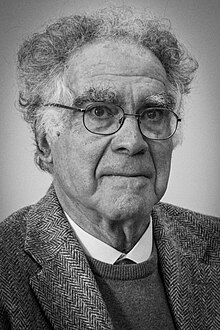Carlo Ginzburg
Carlo Ginzburg | |
|---|---|
 Carlo Ginzburg 2013 | |
| Born | April 15, 1939 Turin, Italy |
| Nationality | Italian |
| Alma mater | University of Pisa |
Carlo Ginzburg (Italian: [ˈkarlo ˈɡintsburɡ]; born April 15, 1939[1]) is a noted Italian historian and proponent of the field of microhistory. He is best known for Il formaggio e i vermi (1976, English title: The Cheese and the Worms), which examined the beliefs of an Italian heretic, Menocchio, from Montereale Valcellina.
In 1966, he published The Night Battles, an examination of the benandanti visionary folk tradition found in sixteenth- and seventeenth-century Friuli in northeastern Italy. He returned to looking at the visionary traditions of early modern Europe for his 1989 book Ecstasies: Deciphering the Witches' Sabbath.
Life
The son of Natalia Ginzburg and Leone Ginzburg, Carlo Ginzburg was born in 1939 in Turin, Italy. He received a PhD from the University of Pisa in 1961. He subsequently held teaching positions at the University of Bologna, the University of California, Los Angeles (1988–2006), and the Scuola Normale Superiore di Pisa. His fields of interest range from the Italian Renaissance to early modern European history, with contributions to art history, literary studies, and the theory of historiography.
In 1979, Ginzburg formally requested that the former Pope John Paul II open the Inquisition Archives. While the immediate response of the Vatican has not yet come to light, a limited group of scholars had been granted access by 1991. In January 1998 the archives were formally opened to "qualified researchers." Cardinal Ratzinger (who later became Pope Benedict XVI) credited Ginzburg, and his 1979 letter, as having been instrumental in the Vatican's decision to open these archives.[2] Ginzburg had his doubts about using statistics to reach a judgment about the period. “In many cases, we don’t have the evidence, the evidence has been lost,” said Ginzburg.[3]
Along with Paul Ginsborg, Marcello Flores, Sergio Luzzatto, Claudio Pavone, Enzo Traverso, etc., Ginzburg called, in January 2002, for the rejection of a bill, presented by Justice Minister Clemente Mastella, that would have outlawed Holocaust denial. They argued that Italy's legislation was sufficient to cope with such acts. The amended bill finally restricted itself to reinforcing sentences concerning hate speech.[4]
He was awarded the 2010 Balzan Prize[5] and was elected an International Member of the American Philosophical Society in 2013.[6]
Work
In The Night Battles and Ecstasies, Ginzburg traced a complex path from certain European witch persecutions to the benandanti and a wide variety of practices which he describes as evidence of a substrate of shamanic cults in Europe. His 1999 work, The Judge and the Historian, sought to expose injustice in the trial of Adriano Sofri, but failed to win a new trial. His book was not only about Sofri, but was also a general reflection on the scientific methods used by a historian, and their similarity to the work of a judge, who also has to correlate testimonies with material evidence in order to deduce what really happened. Thus, he explains how the judicial model of early historiography made it focus on easily verifiable facts, resulting in studies that centered on individuals or on what Lucien Febvre and Marc Bloch called in the Annales d'histoire économique et sociale an "evenemential history."
Bibliography
- The Cheese and the Worms: The Cosmos of a Sixteenth Century Miller, Baltimore: Johns Hopkins University Press, 1980, ISBN 0-8018-4387-1. First published in Italian as Il formaggio e i vermi, 1976.
- The Night Battles: Witchcraft and Agrarian Cults in the Sixteenth and Seventeenth Centuries, Johns Hopkins University Press, Baltimore, 1983, ISBN 0-8018-4386-3. First published in Italian as I benandanti, 1966.
- Umberto Eco; Thomas Sebeok, eds. (1984), "Morelli, Freud, and Sherlock Holmes: Clues and Scientific Method", The Sign of Three: Dupin, Holmes, Peirce, Bloomington, IN: History Workshop, Indiana University Press, pp. 81–118, ISBN 978-0-253-35235-4
{{citation}}: Italic or bold markup not allowed in:|publisher=(help) - The Enigma of Piero, London, 1985 (revised edition, 2000), ISBN 0-86091-904-8.
- Clues, Myths and the Historical Method, Johns Hopkins University Press, Baltimore, 1989, ISBN 0-8018-4388-X.
- Ecstasies. Deciphering the Witches' Sabbath, New York, 1991, ISBN 0-226-29693-8. First published in Italian as Storia notturna: Una decifrazione del Sabba, 1989.
- Wooden Eyes, Milan, 1998, ISBN 0-231-11960-7.
- The Judge and the Historian. Marginal Notes and a Late-Twentieth-century Miscarriage of Justice, London 1999, ISBN 1-85984-371-9. First published in Italian as Il giudice e la storico (1991).
- History, Rhetoric, and Proof. The Menachem Stern Jerusalem Lectures, London and Hanover 1999, ISBN 0-87451-933-0.
- Das Schwert und die Glühbirne. Eine neue Lektüre von Picassos Guernica, Frankfurt am Main 1999, ISBN 3-518-12103-0.
- No Island is an Island. Four Glances at English Literature in a World Perspective, New York 2000, ISBN 0-231-11628-4.
- Un dialogo, Milano, 2003.
- Threads and Traces: True, False, Fictive, (papers), University of California Press, 2012, ISBN 9780520274488
- Latitude, Slaves and the Bible: An Experiment in Microhistory (PDF) Online paper by Carlo Ginzburg.
See also
- Leone Ginzburg (father), Natalia Ginzburg (mother)
- Vatican Secret Archives
- Menocchio, accused of heresy
References
- ^ Università degli Studi di Bologna. Professori ordinari Archived March 18, 2013, at the Wayback Machine
- ^ Putting the Inquisition on Trial, Los Angeles Times, April 17, 1998
- ^ http://www.nbcnews.com/id/5218373/ns/world_news/t/vatican-downgrades-inquisition-toll/#.VP8gMPnF-Sp
- ^ Sous la pression des historiens, l’Italie renonce à pénaliser le négationnisme, Human Rights League (LDH), February 1, 2007 Template:Fr icon
- ^ Balzan Prize winners in 2010, from the website of the Fondazione internazionale Premio Balzan
- ^ https://www.amphilsoc.org/members/electedApril2013
External links
- Ginzburg UCLA Homepage
- Carlo Ginzburg at the International Balzan Prize Foundation
- On the Dark Side – Ginzburg interview
- Review of Cheese and the Worms (PDF) at the Wayback Machine (archive index)
